|
Front Page News Items From
2005 |
|
|
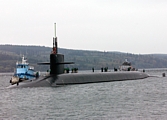
US SSBNs are now tasked
under new preemption war plan |
New Nuclear Notebook Published in
the Bulletin of the Atomic Scientists
US Nuclear Forces Profiled
(December 29, 2005)
The US military has
made nuclear strike plans "more flexible" for "a
wider range of contingencies,"
dramatically increased the strategic submarine force
in the Pacific to target China, and put long-range
forces on near-alert under a new offensive strike
plan that implements the Bush administration's
preemption doctrine. This and more in the
latest Nuclear Notebook in the
Bulletin of the Atomic Scientists as the
Pentagon prepares to complete a new Nuclear Posture
Review early in 2006. |
|
|
New Article Published By The Royal
Canadian Military Institute
"Preparing
For The Failure Of Deterrence"
(December 8, 2005)
The
Royal Canadian Military Institute has published
an article about how U.S. nuclear planners are
preparing for the failure of deterrence by putting
new strike plans into operation onboard long-range
bombers and strategic submarines. This includes
options to strike preemptively with nuclear weapons,
if adversaries make preparations to use weapons of
mass destruction. Some U.S. lawmakers (see below)
recently objected to such a broadening of the role
of U.S. nuclear weapons. |
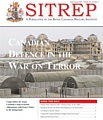
New Article |
|
|
|
|
|
New STRATCOM Joint Functional
Component Command for Space and Global Strike
Global Strike Command Achieves Initial Operational
Capability
(December 1, 2005)
On
November 18, 2005, U.S.
Strategic Command's new Space a Global Strike command achieved Initial Operational Capability
(IOC) at Offutt
Air Force Base, Nebraska. The new command, is tasked with implementing the
new Global Strike mission assigned to STRATCOM in
2003. This includes CONPLAN 8022, a new strike plan
that includes preemptive nuclear strike against weapons of mass
destruction facilities anywhere in the world. For
additional information,
see here. |
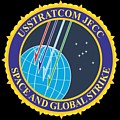
Global Strike Command
Achieves IOC |
|
|
|

Rumsfeld in
"old Europe" |
US sends
nuclear ball back into European court
Rumsfeld: Europeans Keep Nukes In Europe (November
3, 2005)
During
an interview with the German magazine Der Spiegel
on October 31, U.S. Defense Secretary Donald
Rumsfeld suggested that it is European governments,
not the United States, that are responsible for the
lingering deployment of U.S. nuclear bombs in Europe.
Rather than defending the mission of the
weapons, Rumsfeld said: "Some European countries in
Europe made the decision to allow them to be on the
continent. It was seen to be in their interest and
is still seen that way today." For more background,
go here or read the report "US
Nuclear Weapons In Europe." |
|
|
|
|
|
|
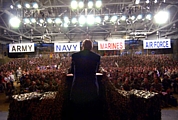
Rumsfeld reaffirms U.S.
nuclear umbrella over South Korea |
Continuing
nuclear deterrence on the Korean Peninsula
Nuclear Umbrella Over Korea Reaffirmed (October
24, 2005)
Less than a month after
the United States pledged
"it has no intention to
attack...[North Korea] with nuclear...weapons,"
Defense Secretary
Donald Rumsfeld
reaffirmed the "continued provision of a nuclear
umbrella for [South Korea]" that includes nuclear
strike planning against targets in North Korea.
Rumors about modifying the nuclear umbrella turned
out not to be true, missing an important opportunity
to move the denuclearization of the Korean Peninsula
forward. |
|
|
|
|
|
|
|
|
|
|
|
|
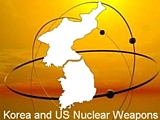 |
New Section Added on U.S. Nuclear
Weapons in South Korea
Korea and U.S. Nuclear Weapons
(September 28, 2005)
On September 19, 2005,
the Bush administration pledged that
it "has
no nuclear weapons on the Korean Peninsula and has
no intention to attack...[North Korea] with
nuclear...weapons."
This new section describes the
history of U.S. nuclear weapons in South Korea and
gives examples of modern nuclear strike planning
against North Korea. |
|
|
|
|
|
|
|
|
|
|
|
|

USS Pennsylvania
arrives at Bangor, Washington, in October 2002. |
Nuclear Weapons Research Cited By
Japanese Kyodo News Service
China At The Center Of SSBN Upgrade
(September 5, 2005)
The
Japanese news wire
Kyodo News reports that the U.S. transfer of
several strategic submarines from the Atlantic to a
new homeport in the Pacific in an
apparent move to keep
China and North Korea in check.
The transfer coincides with a modernization of four
older Pacific-based submarines to the longer-range
Trident II missile, and an upgrade of the W76
warhead on the subs to be able to strike harder
targets. |
|
|
New Nuclear Notebook in the Bulletin of the
Atomic Scientists
Indian Nuclear Forces Profiled
(August 22, 2005)
At the
same the Bush administration is granting India new
privileges, India is gradually becoming a
full-fledged nuclear power with a wide variety of
nuclear weapons for delivery by land, air, and
sea-based forces. The third leg of a nuclear triad
has been test-launched from a warship, according to
this review of Indian nuclear forces published
by the Bulletin of the Atomic Scientists. India has
not yet defined the size of its "minimum deterrent." |
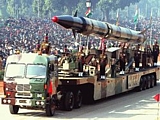 |
|
|
|
 |
Chapter on World Nuclear Forces in
SIPRI Yearbook
SIPRI Chapter Profiled by Global Security Newswire
(August 17, 2005)
The news
wire service Global Security Newswire made the
latest overview of World Nuclear Forces published in
the SIPRI Yearbook for 2005 their top story. Under
the headline
eight countries
countries currently deploy an estimated 13,470
nuclear weapons, with another 14,000 weapons held in
reserve. |
|
|
New Section Added About Russian
Nuclear Submarine Patrols
Russian Nuclear Submarine Patrols
(August 3, 2005)
Once seen
as one of the most formidable threats to the United
States, Russian ballistic missile submarines today
rarely sail on deterrent patrols. Attack submarine
patrols have also almost ended. Information obtained
from the U.S. Navy shows the dramatic decline since
1981 at the height of the Cold War. Surprisingly,
the change began several years before the fall of
the Berlin Wall and the collapse of the Soviet
Union. |

Russian nuclear
submarines are
spending most of their time in port |
|
|
|

US nuclear bombs in Europe
continue to be political
issue
in Belgium |
Calls Continue in Europe for
Change to NATO Nuclear Policy
Belgian
House of Representatives Calls For Withdrawal of US
Nuclear Bombs From Europe (July
15, 2005)
Only a month
after
NATO reaffirmed the continued deployment of US
nuclear bombs in Europe, the Belgian House of
Representatives on July 13th passed
a resolution calling for the withdrawal of those
bombs and not to deploy any in new NATO member
states. The resolution follows the Belgian Senate's
unilateral resolution in April also calling for
a withdrawal. For background, see
U.S. Nuclear Weapons In Europe. |
|
|
New FOIA Document and Analysis
Section Added
Deterring Proliferators of Weapons of Mass
Destruction
(July 11, 2005)
The role
of nuclear weapons in deterring "rogue" states armed
with weapons of mass destruction has become an
important element of post-Cold War US nuclear policy
and strategy, and a contentious element of the
public debate. Declassified documents from
Working Group 5 of the 1994 Nuclear Posture
Review provide insight into the rationale and
limitations of this new mission. |

Deterring Proliferators |
|
|
|
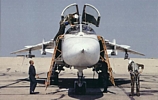
Ukraine says it will not permit NATO to deploy
nuclear
bombs at Ukrainian air bases |
Another Reality Check For NATO's
Nuclear Policy
Ukraine Says
"No" To NATO Nukes (July
5, 2005)
Ukrainian
defense minister
Anatoliy Grytsenko told
Interfax on June 30th that "there
will be no nuclear arms on our territory" if Ukraine
joins NATO.
The NATO Nuclear
Planning Group
declared on June 9 that widespread deployment of
US nuclear bombs in Europe is necessary, but
Grytsenko said "there
is no need to deploy such weapons, as nuclear arms
have almost unlimited range." See also report
U.S. Nuclear Weapons In Europe. |
|
|
Victory For the Freedom of
Information Act
OSD Overrules STRATCOM FOIA Fee Determination
(June 23, 2005)
In an important
victory for the Freedom of Information Act, the Office of the Secretary
of Defense
has ruled in favor of my appeal of STRATCOM's fee
determination and established that I "meet the criteria of a representative
of the news media." The ruling ends a dubious effort by STRATCOM to
establish new restrictions on who can use of the
FOIA and how much they must pay. |
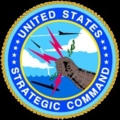
STRATCOM looses FOIA
fee appeal |
|
|
|

French nuclear
modernization |
New Nuclear Notebook Published
French Nuclear Forces Profiled (June
21, 2005)
Approximately
ten nuclear cruise missiles are routinely carried
onboard the French aircraft carrier Charles de Gaulle,
according to the latest
Nuclear Notebook in the
Bulletin of the Atomic Scientists. France is
the only nuclear power that routinely deploys
tactical nuclear weapons at sea. Another 340
operational nuclear warheads arm missiles on
strategic submarines and land-based strike aircraft.
All of these weapons are scheduled to be replaced
with new and more capable missiles with upgraded
warheads over the next ten years. |
|
|
Secret Nuclear War Planning
Guidance Document Profiled
Joint Strategic Capabilities Plan Nuclear Supplement
(June 16, 2005)
One of the most secret
U.S. nuclear weapons planning guidance documents has
been partially declassified. Although most of the
sensitive portions of the document, known as CJCSI
3110.04, were deleted before release, the remaining
sections for the first time reveal the structure and
elements of a document few have ever seen before.
|
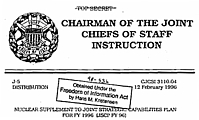
Top Secret nuclear weapons
planning
guidance document declassified |
|
|
|

NATO Nuclear Policy:
"Same procedure as every year." |
Nuclear Policy Seems Frozen In
Time
NATO Reaffirms Nuclear Deployment
(June 9, 2005)
The North
Atlantic Treaty Organization (NATO) today reaffirmed
the deployment of U.S. nuclear bombs in Europe in
quiet rejection of Belgian and German suggestions
that the weapons should be withdrawn. The
reaffirmation came in
the Final Communiqué from the Nuclear Planning Group
on the first of a two-day meeting in Brussels. The
language is almost identical to the language from
the previous Communiqué in December 2003. See
also the report:
U.S. Nuclear Weapons In Europe. |
|
|
Nuclear Initiative Dies At The
Hands Of Government Bureaucrats
Germany Retreats on U.S. Nuclear
Weapons Withdrawal
(June 5, 2005)
According
to
a report in Der Spiegel,
the German government has decided not to raise the
issue of withdrawal of US nuclear weapons from
Germany after all. With an upcoming national
election, the
Schröder government did not want to tie the hands of
the next government or risk a clash with the United
States. For background on U.S. nuclear weapons in
Europe,
see
report. |
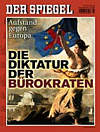 |
|
|
|

Name Change For
The Ultimate Plan? |
Some Things Are Just Hard to do:
Changing the SIOP Nomenclature
US Nuclear Strike Plan Finally Adopts Name
Proposed More Than a Decade Ago
(May 17, 2005)
Thirteen years
after STRATCOM's first commander, General George Lee
Butler informed the Joint Chiefs of Staff that he
had decided to rename the SIOP, the Chiefs appear
to finally have conceded. Yet some things are known
by many names, and the nation's nuclear war plans
are no different. See update box on the
SIOP name page. |
|
|
|
|
|
|

Does NATO Violate
the NPT Treaty? |
Nuclear Strike Mission of
Non-Nuclear NATO Countries Issue at NPT Conference
in New York
NATO's
"Nuclear Sharing" Raised at UN Nuclear
Non-Proliferation Conference
(May 10, 2005)
On behalf of the
non-aligned members of the Non-Proliferation Treaty
(NPT),
Malaysia called on May 2nd for an end to
"nuclear sharing for military purposes under any
kind of security arrangements."
Egypt said it would examine whether "nuclear
sharing" constitutes a violation of the treaty.
Five non-nuclear NATO countries have fighter-jets
equipped to deliver US nuclear weapons in war,
according to the
report
US Nuclear Weapons In Europe. |
|
|
German Government Responds to
Domestic Nuclear Pressure
US Nuclear Weapons Deployment in Europe to be Raised
by Germany in NATO
(May 9, 2005)
Germany plans to raise the issue of US nuclear
weapons in Europe within NATO, German defense
minister Peter Struck said during a visit to
Ramstein Air Base. He said Germany also plans to
discuss the matter with the other NATO countries
where US nuclear weapons are stored. The report in
Deutche Welle uses the research from the
report
US Nuclear Weapons In Europe. NATO will meet
next time in June. |

German Defense Minister
Peter Struck Plans to Raise Question of US Nuclear
Weapons in Europe |
|
|
|

Nuclear dilemma |
|
Should US Nukes Be Withdrawn? |
| |
Overall |
CDU/CSU |
SPD |
Greens |
FDP |
|
Yes |
76 |
73 |
82 |
90 |
66 |
|
No |
18 |
24 |
15 |
5 |
29 |
|
Source: Der Spiegel (18/2005) |
NATO Nuclear Policy Looses Support
in Germany
Large Majority
of Germans Favors Withdrawal of US Nuclear Weapons
(May 2, 2005)
A poll published by the German magazine
Der Spiegel
shows that more than three-quarters of the German
public want U.S. nuclear weapons withdrawn from
Germany. Der Spiegel asked 1,000 Germans if they
wanted the 150 US nuclear bombs in Germany
withdrawn, the number from the
report
US Nuclear Weapons In Europe. |
|
|
New Document Collection Published
The Birth of a Nuclear Bomb: B61-11 (April
27, 2005)
An
extensive collection of FOIA documents provides
new insight into the design, production and mission
of the B61-11 earth-penetrating nuclear bomb. This
history of the B61-11 provides an important
background for understanding how the Bush
administration plans to develop and produce the
Robust Nuclear Earth Penetrator (RNEP). |
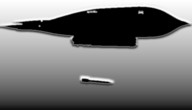 |
|
|
|
|
|
|
|
|
|
|
|
New Information About A Possible
Design Flaw In America's Most Numerous Warhead
New York Times Article on W76 Uses Research
(April 2005)
The nuclear warhead that makes up the backbone of
the United States' nuclear deterrence may have a
flaw, according to
a New York Times article. More than 1,700 of the
100-kilotons W76 warhead currently arm 336 Trident
missiles on a dozen Ohio class submarines, according
to the
latest Nuclear Notebook. Although the rumor has
been around from some time, the
New York Times article
brings new information to
light. |

A W76 warhead is released from a
Trident missile "bus" |
|
|
|
|
|
Change In NATO Review Of Nuclear
Planning
NATO
Nuclear Planning Group Slows Down
(March 2005)
The Nuclear Planning Group (NPG) of the
North Atlantic Treaty Organization (NATO) will
only meet once a year in the future, ending a
decade-long tradition of meeting twice a year to
review the alliance's nuclear policy and war plans.
The slower pace is the result of a "Ministerial
streamlining," according to information received
from NATO.
The NPG met last time in December 2003, held no
meetings at all in 2004, and will meet for the first
time in accordance with the new schedule in June
2005. |
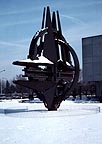 |
|
|
|

Beg sees NATO nuclear planning as
model for
Pakistani-Indian nuclear umbrella over Iran |
U.S.
Nukes In Europe Trigger Proposal For
Pakistani-Indian Nuclear Umbrella Over Iran
Pakistan's Former Army Chief Refers to Euro Report
(March 2005)
General
Mirza Aslam Beg, who
was chief of Pakistan's Army from 1988 to 1994 and
involved in Pakistan's development of nuclear
weapons capability, refers to the report "U.S.
Nuclear Weapons In Europe" in an opinion piece
published by UPI. General Beg calls the
U.S. practice of "outsourcing" nuclear strike
missions to non-nuclear NATO countries "interesting as well as regrettable" and
characterizes it as "enlightened nuclear
proliferation." Yet in
another publication, Beg
says that Pakistan and Indian should do the same in Iran. |
|
|
|
|
|
|
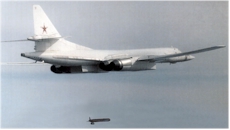
Tu-160 Blackjack drops AS-15
nuclear cruise missile |
New Nuclear Notebook
Published in
Bulletin of the Atomic Scientists
Russian Nuclear Forces Profiled
(February 2005)
The number of nuclear
warheads on Russia's operational land-based
strategic nuclear missile force will decrease by
nearly 70 percent over the next five years,
according to
the latest Nuclear Notebook. The result will be
a total arsenal that is more balanced between land-
and sea-based missiles. The bomber force will remain
essentially the same size, but with new weapons. |
|
|

New Air Force
Threat Assessment |
Latest Threat
Assessment Obtained From the Air Force
Ballistic and Cruise Missile Threat
(February 2005)
The U.S. Air Force's
National Air and Space Intelligence Center has
published an updated assessment of the ballistic and
cruise missiles threat. The document provides the
Air Force's view of the world's potential threats
against the United States with details about status
and capabilities of individual weapon systems. Both
the latest revised threat assessment and the
previous version from 2000 are made available
here. |
|
|
New Book About Code
Names Discloses Secrets and Secrecy
Secret Code Names See The Light of Day
(January 2005)
In the 9/11 world the
U.S. military and intelligence organizations have
created secret plans, programs, and operations at a
frenzied pace, each with their own code name,
according to a new book by defense analyst
William M. Arkin. The book,
Code Names: Deciphering U.S. Military Plans,
Programs and Operations in the 9/11 World (Steerforth
Press, 2005), shows that while most genuine secrets
remain secret, other activities labeled as secret
are either questionable or remain perfectly in the
open.
Code Names identifies more than 3,000 code
names and details the plans and missions for which
they stand. This book is a must for anyone working
against excessive secrecy. |
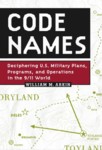
New Book by Arkin |
|
|

U.S. Nuclear
Arsenal Profiled |
New Nuclear Notebook
Published in the
Bulletin of the Atomic Scientists
New Name For U.S. Nuclear War Plan
(January 2005)
The
United States has formally changed the name of its
strategic nuclear war plan, according to the Nuclear
Notebook. Known as the SIOP (Single Integrated
Operational Plan) for the past 44 years, the war
plan is now known as OPLAN 8044. Changing the plan
into an Operations Plan reflects an attempt to make
nuclear planning more flexible and more coherent
with conventional war planning.
(click
here for brief about name change) |
|
|
|
See also: Front Page News Items from
2008,
2007,
2006 and
2004 |
|
|

